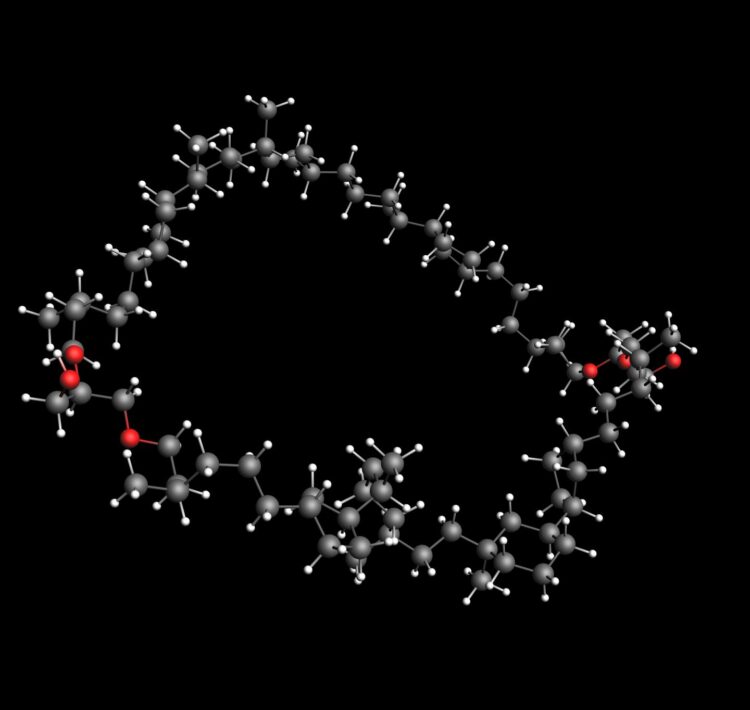
Credit: Adri Minnaard, University of Groningen
Crenarchaeol is a large, closed-loop lipid that is present in the membranes of ammonium-oxidizing archaea, a unicellular life form that exists ubiquitously in the oceans. In comparison to other archaeal membrane lipids, crenarchaeol is very complex and, so far, attempts to confirm its structure by synthesizing the entire molecule have been unsuccessful. Organic chemists from the University of Groningen have taken up this challenge and discovered that the proposed structure for the molecule was largely, but not entirely, correct.
Crenarchaeol contains 86 carbon atoms and is a ‘macrocycle, a large closed loop. No fewer than 22 positions in the molecule are chiral. The molecule can be present in two forms that are each other’s mirror image, like a left and a right hand. In the crenarchaeol molecule, all 22 chiral centres have their own specific ‘handedness’. Furthermore, crenarchaeol contains a very uncommon cyclohexane group.
Challenge
This complex molecule was first isolated in 2002 by Jaap Sinninghe Damsté and colleagues at the Royal Netherlands Institute for Sea Research, NIOZ. They identified its structure using spectroscopic techniques but their result has never been confirmed. This is surprising because ammonium-oxidizing archaea play a key role in the oceanic nitrogen cycle and fossil crenarchaeol and its companion lipids are widely used by molecular palaeontologists to reconstruct past sea temperatures. ‘The structure of crenarchaeol is a formidable challenge for synthetic organic chemistry,’ says Adri Minnaard, Professor of Organic Chemistry at the University of Groningen. ‘And we decided to take it up.’
First, 3 milligrams of the natural compound were isolated and purified at NIOZ, which took about three months. There are only tiny amounts of crenarchaeol in each cell, just 0.000000001 gram, but because there are so many of these cells in the world’s oceans and since the molecule is very stable and has accumulated in the sediment for millions of years, it is believed to be one of the most abundant organic molecules in marine sediments.
Mount Everest
There are several problems with synthesizing crenarchaeol; getting all the chiral centres in the correct orientation is one of them. ‘And the molecule contains a lot of carbon-carbon bonds, which are difficult to construct.’ But it is a challenge that a synthetic organic chemist cannot resist – just like an ambitious mountaineer cannot resist Mount Everest. Minnaard showed the structure to his PhD student Mira Holzheimer, who worked on palladium-catalyzed synthetic reactions. ‘Her literal response was: “I want to climb that mountain”.’ They made a plan of attack on paper, which involved taking the molecule apart into the building blocks that could be synthesized. This produced a tentative route towards the synthesis of complete crenarchaeol molecules, which Holzheimer explored.
Similar to climbing a mountain for the first time, the synthetic route that they designed at the start sometimes led to a dead end. This meant retracing these steps and trying a new approach. ‘You start with multiple grams of the basic compounds. But in each of the more than 65 intermediate steps, you lose material, sometimes up to 50 per cent. And if you run out of intermediates, you have to go all the way back again,’ Minnaard explains.
Shock
After three years of hard work, Holzheimer had produced a large chunk of the molecule, roughly half of the macrocycle. Minnaard: ‘At that stage, we decided to check it against the corresponding part of natural crenarchaeol.’ This was done using coupled gas chromatography-mass spectrometry. The comparison was made at NIOZ and the results came as a shock: ‘We synthesized the correct carbon skeleton, but the chromatographic behaviour was not the same as that for natural crenarchaeol. Something was wrong’, Minnaard recalls.
After two days of checking, Minnaard and Holzheimer concluded that they really had made the proposed structure. And as it did not match completely with natural crenarchaeol, this could only mean one thing: the proposed structure was not entirely correct. The results pointed towards one of the chiral centres of the unusual cyclohexane group. ‘Our collaborators at NIOZ mis-assigned just one chiral centre out of 22.’ The structure correction was further supported by calculations on the spectra of both natural and prepared crenarchaeol, which were performed by Prof. Remco Havenith and Dr Ana Da Cunha. Minnaard: ‘This shows the value of synthetic chemistry: building a proposed structure is the gold standard for validation.’
Art
Such a complex build as with crenarchaeol does bring some additional pay-offs: ‘We had to develop new synthetic tools, that are now added to the organic synthesis toolbox.’ Furthermore, having the correct structure is relevant for scientists who are studying archaeal membranes. This is usually done through molecular dynamics simulation, explains Minnaard, and the entirely correct structure is now available. Yet this pay-off is not the biggest motivation for Minnaard to take on these projects: ‘It doesn’t always have to have a purpose. To me, building molecules can be art.’
###
Reference: Mira Holzheimer, Jaap S. Sinninghe Damsté, Stefan Schouten, Remco W. A. Havenith, Ana V. Cunha, Adriaan J. Minnaard: Total Synthesis of the Alleged Structure of Crenarchaeol Enables Structure Revision, Angewandte Chemie, first online 11 juni 2021.
Media Contact
Rene Fransen
[email protected]
Original Source
https:/
Related Journal Article
http://dx.





